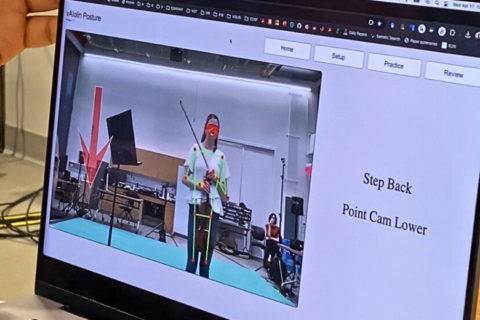There are 2,000 miles of road in Baltimore City. Only 10 of those miles include separated bike infrastructure that divides the road into distinct lanes for cars and bikes.
This is not unique to Baltimore City. Across the state, only fractions of county roadway systems include bike infrastructure, the markers, barriers and laws — like a reduced speed limit — that allow bicyclists to safely share the road with motorists.
A Capital News Service data analysis of Maryland Highway Safety Office crash data found that of the average of 813 crashes that occurred each year from 2016 to 2020, only 4.7% occurred in a bikeway, a road or street path designated for bicycle use. An overwhelming majority of crashes took place on roads without bike infrastructure.
“Many U.S. cities are very heavily designed around the car,” said Romic Aevaz, a policy analyst at the Eno Center for Transportation in Washington, D.C. “Having protected bike infrastructure is incredibly important because it gives you the opportunity to safely bike around your neighborhood or your city without fear of getting into a catastrophic crash with a motorist.”
While Maryland ranks 14 in the country as a bicycle-friendly state, according to a 2019 report from the League of American Bicyclists, bike advocacy groups across the state have pushed for infrastructure changes and legislative action to protect bicyclists. These concerns are well-founded, as there is an 81% chance a crash will result in an injury, according to Maryland crash records.
But rebuilding roads to accommodate bikes takes funding, something smaller, local jurisdictions may not have the capacity to apply for without additional state support.
Current Maryland state funding for bike infrastructure comes from the Kim Lamphier Bikeways Network Program, with additional federal funding from the Recreational Trails Program and the Transportation Alternatives Program, the latter of which will increase by 60% by 2026 due to the recently passed Infrastructure Investment and Jobs Act.
It is with this funding that Governor Larry Hogan recently announced $16.8 million in September for bicycle and pedestrian projects.
The MDOT State Highway Administration is planning to provide an additional $118 million in funding for bike and pedestrian improvements between 2022 and 2027 and earlier this year implemented the latest update to the state’s five-year Strategic Highway Safety Plan, which places a “core emphasis” on bicycle and pedestrian improvements, said Sherry Christian, spokesperson for MDOT.
“Although the COVID pandemic has impacted all areas of our programs, the Maryland Department of Transportation is committed to continuing to invest in improving safety throughout the state and looks to add funding as it becomes available to areas where we have critical needs including our bicycle and pedestrian funds and Vision Zero efforts,” Christian said.
Across the state, Baltimore City has the highest number of crashes adjusted for population, and the highest overall.
In the city, where about one third of households don’t own a car according to the Baltimore City Department of Transportation, advocates say bikes could fill an obvious transportational need, but bike lanes don’t extend throughout the city.
This is especially dangerous for bicyclists crossing at intersections, where bike lanes rarely exist and the highest average percentage of crashes and injuries occurred over the past five years throughout the state.
A local advocacy group, Bikemore, is currently working on a plan to connect 85% of Baltimore neighborhoods with separated bike infrastructure. While the plan was approved under the former City Council, the group hopes the new council, under Mayor Brandon Scott, will be able to allocate financial support for the plan.
“If you build it, they will come,” said Jed Weeks, Bikemore’s interim executive director and policy director. “When you build that infrastructure the riders rapidly develop where they weren’t before.”
Researchers, like Aevaz and Daniel Rodriguez, associate director of the Institute for Transportation Studies at University of California, Berkeley, also said that adding bike infrastructure can help reconnect communities that have been torn apart by highways and road construction, making it difficult for people to travel to school or work.
“One of the key challenges of bicycle infrastructure in fact is that it’s very sensitive precisely to those barriers,” Rodriguez said. “Think about a river without a bridge. That’s exactly what that highway looks like.”
This issue exists in Worcester County too, where Route 50, which connects Marylanders to Ocean City, a popular beach tourist destination, and other highways segment the county. MDOT recently constructed a shared use path along the final stretch of Route 50 across the bridge to Ocean City.
Complicating matters even more, Worcester County is unique in that it accommodates more than 300,000 visitors on a peak summer weekend to Ocean City, according to State Ventures LLC, pushing the population to look more like that of Howard County.
The state, however, only allocates funding to Worcester County based on its year-round population of 52,460, which does not take into account the county’s seasonal population surge, according to Patti Stevens, co-chair of the Worcester County Bike and Pedestrian Advisory Coalition.
“It’s hard to do [bike] education and outreach when you don’t have a standard population,” Stevens said.
She said it’s also challenging for smaller jurisdictions in the county to implement large bike projects because they don’t have the bandwidth or the workforce of a larger county.
Stevens hopes the coalition, which was recently created in June 2020, will encourage increased collaboration across the Eastern Shore, so that they can organize more effectively as a regional unit for increased bicycle infrastructure.
According to Christian, MDOT continues to seek feedback from local program sponsors as they problem solve how to improve the administration of TAP funds. MDOT recently updated the TAP manual and application to streamline the process.
However, in order to build bike infrastructure, counties need legislative and financial support from the state and federal government.
In this upcoming legislative session, bike advocates across Maryland are currently supporting three bills meant to make roads safer that already have sponsors in the House of Delegates, according to the Washington Area Bicyclist Association’s board member Peter Gray.
The first, if passed, would mandate the SHA to investigate any crash involving a fatality and provide recommendations within six months of the crash regarding how to prevent it from happening in the future. The second would mandate the SHA spend a certain amount of money to fix road networks where crashes take place, and the third would enable localities to reduce speed limits on state roads.
While the state and federal government have programs in place to fund state bike projects, advocates say smaller jurisdictions need more support in applying for grants and implementing projects. Additionally, while advocates said they are appreciative that the government has allocated funds in support of bike infrastructure, they said the recent $16.8 million allocation is only a drop in the bucket compared to what the state really needs to bolster its bike infrastructure.
“All of this is preventable with the right type of investment, not just in Baltimore City, but statewide,” Weeks said. “All that is preventable. But we’re not spending the money that way.”







